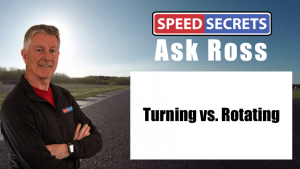 Q: “What I was wondering is how to describe the difference between turning the car and car rotation. We talk about car rotation and using the brakes to effect it, but what is the difference from that compared to turning car with the steering?”
Q: “What I was wondering is how to describe the difference between turning the car and car rotation. We talk about car rotation and using the brakes to effect it, but what is the difference from that compared to turning car with the steering?”
A: Rotating the car involves more slip angle at the rear tires than at the front. Traveling at 5 MPH, for example, the slip angle at the front and rear tires would be equal, and the only thing making the car change direction is the steering angle – the driver turning the steering wheel. At speed – at, near, or over the limit – the car’s balance (load transfer front to rear), and it’s handling characteristics, can result in higher slip angles on the rear tires, and that will result in the car rotating.
Think of rotating a car this way: imagine looking directly down on your car from above, and there is a clockface overlaid on it. Let’s say that you’ve turned the steering wheel enough to make your car point at the 2 o’clock position, but because you’re also trail braking into the corner, there’s more load on the front tires than there is on the rears. That could result in the rear tires having slightly less traction than the fronts — the rear tires have a greater slip angle — and now the car rotates on that clockface so your car is now pointing towards 3 o’clock.
I also look at as the difference between oversteer and rotation is… oversteer is what the car is doing to us; rotation is what we’re doing to the car.
When I was working alongside a number of really great rally instructors, they used to say that the steering wheel was used to “suggest” a direction change, and then everything else was done with the feet. I like that, and it’s related exactly to what you’re asking about.
